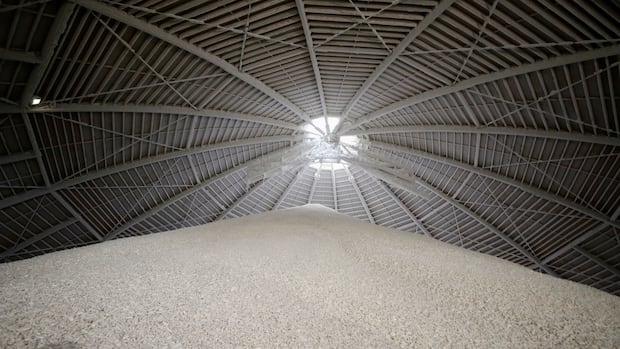SaskatchewanThe Saskatchewan-based potash giant announced last week it plans to build a new terminal at the Port of Longview, WA to handle expected growth in international demand for its fertilizer products.Choosing U.S. over Canada’s ‘onerous regulations’ not surprising, University of Saskatchewan prof saysJeremy Warren · CBC News · Posted: Nov 25, 2025 7:19 PM EST | Last Updated: 5 hours agoListen to this articleEstimated 4 minutesThe audio version of this article is generated by text-to-speech, a technology based on artificial intelligence.A large mound of white potash in a storage facility at the Mosaic potash mine near Belle Plaine, Sask., on July 16, 2025. (Alexander Quon/CBC News)Nutrien’s decision to build a potash export terminal in the U.S. instead of one closer to home in B.C. isn’t surprising, a University of Saskatchewan professor says.The Saskatchewan-based potash giant announced last week that it plans to build a new terminal at the Port of Longview, WA to handle expected growth in international demand for its fertilizer products.Canada’s onerous regulations are likely why Nutrien chose to build the terminal in the U.S., said Stuart Smyth, a professor with the U of S Agricultural and Resource Economics department.“To put a billion-dollar investment in place is going to require rail capacity improvements, and by the sounds of what Nutrient is saying, things are easier to get done in the United States than they are in Canada,” Smyth said last week in an interview with CBC’s The 306 guest host Theresa Kliem.Smyth said the new terminal is part of Nutrien’s plan to expand into India, China and other international markets.Saskatchewan-based Nutrien is the largest potash fertilizer producer and one of the largest potash miners in the world, producing and shipping about 26 million tonnes of potash, nitrogen and phosphate products annually.Nutrien expects global demand to grow in the coming years and chose the Port of Longview based on 30 factors used for site selection, the company said in a statement to CBC News.“The site offers strong rail connectivity, deep-water access and construction feasibility,” it said. “It is intended to complement — not replace — Nutrien’s existing Canadian port capacity.”Nutrien expects to make its “final investment decision” for the project in 2027, the statement said.Planning is in the early stages, but the proposed facility could have an initial capacity of 5 million to 6 million tonnes annually, and while there’s no official budget yet, “projects of this nature generally require in the range of $500 million to $1 billion [USD] over a full build-out,” according to Nutrien’s statement.Stuart said it’s likely that the decision has been in the works for two or three years and pre-dates any tariff-related influences. “They’ve obviously had discussions and consultations and clearly they felt there was a lack of willingness to make any improvements into Canada’s rail infrastructure,” Smyth said.Political reactionThe provincial Opposition NDP and the Sask. Party government took turns responding to Nutrien’s decision after Monday’s question period.“Nutrien has their own shareholders and their own board that they have to be responsible to, so we’re certainly very respectful of that decision,” Trade and Export Development Minister Warren Kaeding told reporters in Regina, adding that it’s “unfortunate that they’ve decided that they need to build outside of Canada.”The province will continue pressing Ottawa to support a “major economic corridor,” Kaeding said.“Whether it’s going east, west, north or south, we need to ensure that we continue to see significant investment from our federal government in supporting all of those opportunities to get products to market.”The Opposition blamed provincial and federal squabbling for hindering any progress on building export infrastructure.“We need more than sabre rattling and chest pounding here,” NDP MLA Sally Housser told reporters on Monday in Regina.“Broken relationships with the federal government and with their provincial counterparts are making it significantly harder to get the job done.”Housser added that “we need to be building all across this province, but particularly export infrastructure to the west — and that includes pipelines.”ABOUT THE AUTHORJeremy Warren is a reporter in Saskatoon. You can reach him at jeremy.warren@cbc.ca.
Nutrien selects U.S. port to build new potash export terminal











